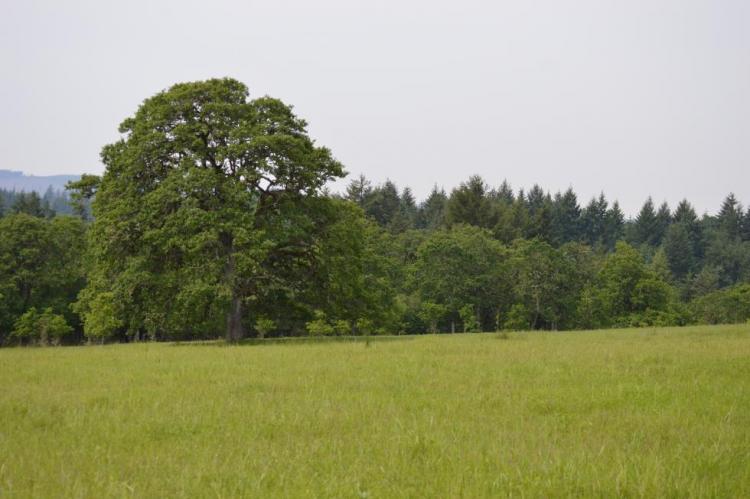
Oak woodlands are characterized by an open canopy dominated by Oregon white oak.
Ecoregional Characteristics
Coast Range
Oak woodland habitats are found in drier landscapes, such as south-facing slopes and foothills bordering the Willamette Valley.
East Cascades
In the East Cascades ecoregion, oak woodlands occur primarily on the north end of the ecoregion and in the Klamath River Canyon. They are located at the transition between ponderosa pine or mixed conifer forests in the mountains, and the shrublands or grasslands to the east. Oak habitats in the East Cascades are different in structure and composition than those in western Oregon but are just as important to a variety of wildlife and rare plants.
Klamath Mountains
Oak woodlands are found in lower elevations, on dry sites, or in areas with frequent, low-intensity fires. Oak woodlands may occur in a mosaic with chaparral and dry conifer woodlands.
West Cascades
Oak woodland habitats are found in drier landscapes, such as south-facing slopes and foothills bordering the Willamette Valley.
Willamette Valley
In the Willamette Valley, oaks were originally found in a mosaic of prairies, oak savanna, and riparian habitats throughout the valley floor and low-elevation slopes. Oaks were most common on flat to moderately rolling terrain, usually in drier landscapes, and often between prairie remnants and conifer forests. Today, oak woodlands generally are found in small, isolated pockets surrounded by other land uses, such as development or agriculture.
Limiting Factors and Recommended Approaches
Limiting Factor: Fire Suppression and Fir Encroachment
With fire suppression, Douglas-fir encroaches into oak habitats and eventually shades out oak trees and seedlings, as well as other plants that require open growing conditions. Many oak woodlands are now dominated by Douglas-fir. Without active management, these areas will eventually become conifer forests. In some areas of the East Cascades, fire suppression combined with grazing has influenced fine fuel production and led to encroachment by conifers and establishment of dense patches of small, shrubby oaks.
Recommended Approach
Use multiple tools, including prescribed fire, mowing, grazing, and selective harvest to maintain open canopy oak-dominated woodlands. Ensure that tools are site-appropriate and implemented to minimize impacts to native species. Re-establish site-appropriate native grasses, herbaceous plants, and shrubs. (KCI: Disruption of Disturbance Regimes)
Limiting Factor: Land Use Conversion and Continued Habitat Loss
Particularly in the Willamette Valley and Klamath Mountains ecoregions, oak woodlands continue to be converted to agricultural (especially vineyards), rural residential, and urban uses.
Recommended Approach
Much of the remaining oak woodland habitat occurs on private land and requires active management, so cooperative incentive programs are the best approach. Work with private landowners to maintain and restore oak habitats. Develop oak products compatible with conservation to promote maintenance of oak as an economic use. Work with local communities to plan development in a manner that conserves critical habitats. (KCI: Land Use Changes)
Limiting Factor: Loss of Habitat Structure
Large-diameter oak trees with lateral limb structure and cavities have been lost. In many areas, there are not sufficient numbers of replacement trees to maintain these habitat elements over time. In the absence of fire, densely-stocked regenerating oaks often do not develop open-grown structures due to shading. In the East Cascades, grazing or very hot fires can lead to development of brushy-structured trees. The shaded or grazed oaks do not develop the lateral limbs, cavities, and higher acorn crops of open-grown trees, and are thus less valuable to wildlife. Woodcutting often removes snags.
Recommended Approach
Maintain a diversity of tree sizes and ages across the stand, with emphasis on large oak and ponderosa pine trees. Remove conifers that are competing with larger oaks. Maintain snags and create snags from competing conifers to provide cavity habitat. Encourage oak reproduction through plantings or protective exclosures. It may be appropriate to use nest boxes as temporary cavity habitat in oak restoration project areas. Improve methods to promote oak reproduction and creation of open-grown structures.
Limiting Factor: Invasive Species
Depending on the ecoregion and site, invasive plants, such as Armenian (Himalayan) blackberry, evergreen blackberry, Scotch broom, English hawthorn, false brome, yellowstar thistle, diffuse knapweed, and puncturevine, invade and degrade oak woodlands. In many oak woodland stands, the overstory is intact but the understory is highly degraded.
Recommended Approach
Identify the best remaining native oak woodlands and work with landowners to maintain habitat quality. Emphasize prevention, risk assessment, early detection, and quick control to prevent new invasive species from becoming fully established. Prioritize control efforts and use site-appropriate methods to control newly-established invasive plant species for which management can be most effective. Re-seed with site-appropriate native grasses and forbs after control efforts. Prescribed burning may be useful for management of some invasive species, particularly shrubs. (KCI: Invasive Species)
Limiting Factor: Climate Change
By the 2080s, the mean annual air temperature in the Pacific Northwest is projected to increase by 2.5-3.4 °C. This warming is projected to be the highest during the summer. Annual precipitation patterns in the Pacific Northwest may also be changing. While there is always uncertainty in projections, the general trend shows winter precipitation to increase and summer precipitation to decrease. Recent climate models have shown conflicting results regarding the effect of projected climate changes on oak habitats throughout Oregon.
Recommended Approach
Protect and restore a diverse portfolio of oak habitats. Continue efforts to restore currently degraded areas and re-establish former oak habitats. Engage in strategic, landscape-scale planning efforts to create a connected and resilient network of oak habitats. Identify where future climate conditions may support oak habitats, including areas upslope of their current range where they were not historically found. Identify data gaps and support research needs. See Adding climate change to the mix: using climate futures in conservation planning for Oregon’s oak-dominated habitats for more information.